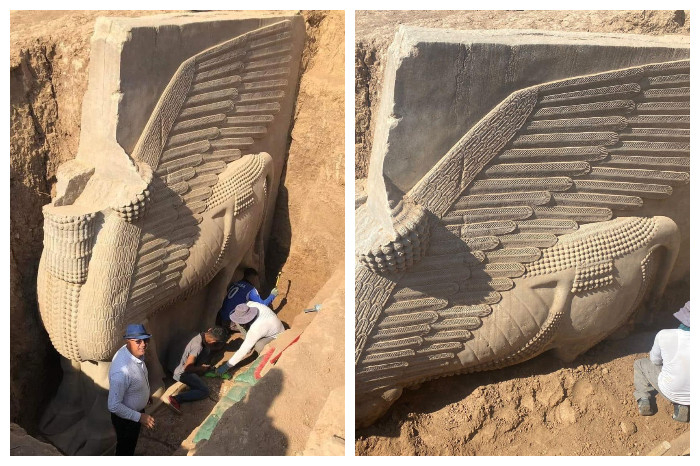A Lamassu sculpture was discovered during excavations in Nineveh province

The sculpture of the "Winged Bull" of Lamassou, discovered during archaeological excavations, will be handed over by the Iraqi Ministry of Culture, Tourism and Antiquities to the Civilization Museum in Mosul. The transfer of the sculpture will take place after the completion of restoration and maintenance work.
Ministry spokesman Ahmed Al-Olaivi said that the discovery of the winged bull shows the importance of the Nineveh region, which is home to the Yazidi population. He also noted that Yazidis and Assyrians are among the closest peoples.
The winged bull, known as Lamassu, was discovered in 1992 in Nineveh, the former capital of the Assyrian state. It was buried in 1995 to protect it from theft. The bull's head was stolen but later found and returned to the Iraq Museum in Baghdad.
After the restoration work is completed, the bull's head will be returned to Mosul and will become one of the valuable exhibits of the Civilization Museum.
This event is an important step in restoring Iraq's cultural heritage, which has been severely damaged by the conflict. It also demonstrates the importance of preserving cultural heritage for all peoples, regardless of their religion or ethnicity.
Here are some additional details about this story:
The winged bull, or Lamassu, is an Assyrian protective deity. He was usually depicted with the head of a bull, the body of a man, and the wings of an eagle.
Nineveh was an important city in the Assyrian Empire. It was founded in the 8th century BC and became the capital of the empire in the 7th century BC.
In 2014, the city of Mosul was captured by ISIS terrorists. They destroyed or damaged many cultural sites, including a winged bull.
In 2017, the city of Mosul was liberated from ISIS militants. Since then, the Iraqi government has been working to restore the city's cultural heritage.
The transfer of the winged bull to the Mosul Museum is an important step in restoring Iraq's cultural heritage. It is also a symbol of hope for the Nineveh region, which has been badly damaged by the conflict.
Tags: #yazidisinfo #newsyazidis #historyyazidis #aboutyazidis
A Lamassu sculpture was discovered during excavations in Nineveh province

The sculpture of the "Winged Bull" of Lamassou, discovered during archaeological excavations, will be handed over by the Iraqi Ministry of Culture, Tourism and Antiquities to the Civilization Museum in Mosul. The transfer of the sculpture will take place after the completion of restoration and maintenance work.
Ministry spokesman Ahmed Al-Olaivi said that the discovery of the winged bull shows the importance of the Nineveh region, which is home to the Yazidi population. He also noted that Yazidis and Assyrians are among the closest peoples.
The winged bull, known as Lamassu, was discovered in 1992 in Nineveh, the former capital of the Assyrian state. It was buried in 1995 to protect it from theft. The bull's head was stolen but later found and returned to the Iraq Museum in Baghdad.
After the restoration work is completed, the bull's head will be returned to Mosul and will become one of the valuable exhibits of the Civilization Museum.
This event is an important step in restoring Iraq's cultural heritage, which has been severely damaged by the conflict. It also demonstrates the importance of preserving cultural heritage for all peoples, regardless of their religion or ethnicity.
Here are some additional details about this story:
The winged bull, or Lamassu, is an Assyrian protective deity. He was usually depicted with the head of a bull, the body of a man, and the wings of an eagle.
Nineveh was an important city in the Assyrian Empire. It was founded in the 8th century BC and became the capital of the empire in the 7th century BC.
In 2014, the city of Mosul was captured by ISIS terrorists. They destroyed or damaged many cultural sites, including a winged bull.
In 2017, the city of Mosul was liberated from ISIS militants. Since then, the Iraqi government has been working to restore the city's cultural heritage.
The transfer of the winged bull to the Mosul Museum is an important step in restoring Iraq's cultural heritage. It is also a symbol of hope for the Nineveh region, which has been badly damaged by the conflict.
Tags: #yazidisinfo #newsyazidis #historyyazidis #aboutyazidis


























